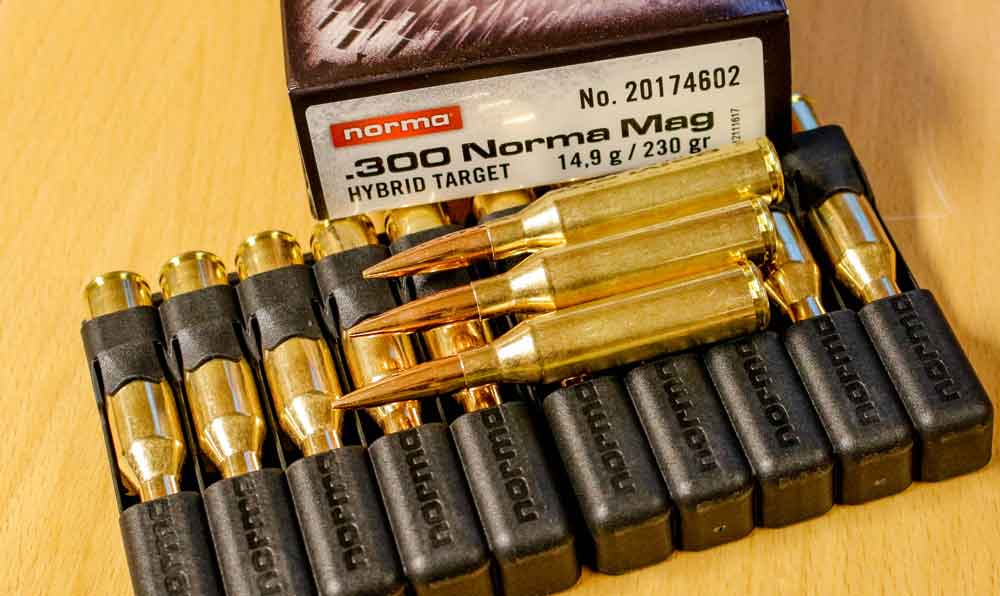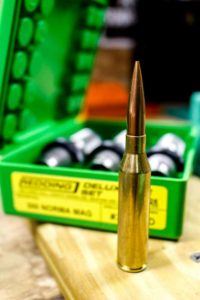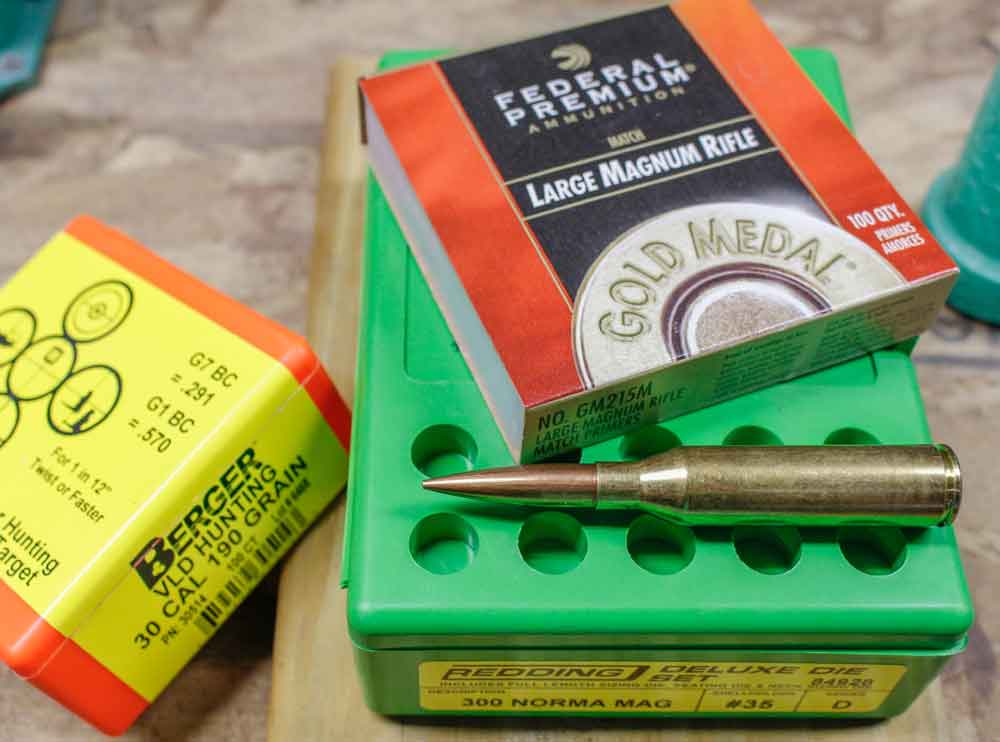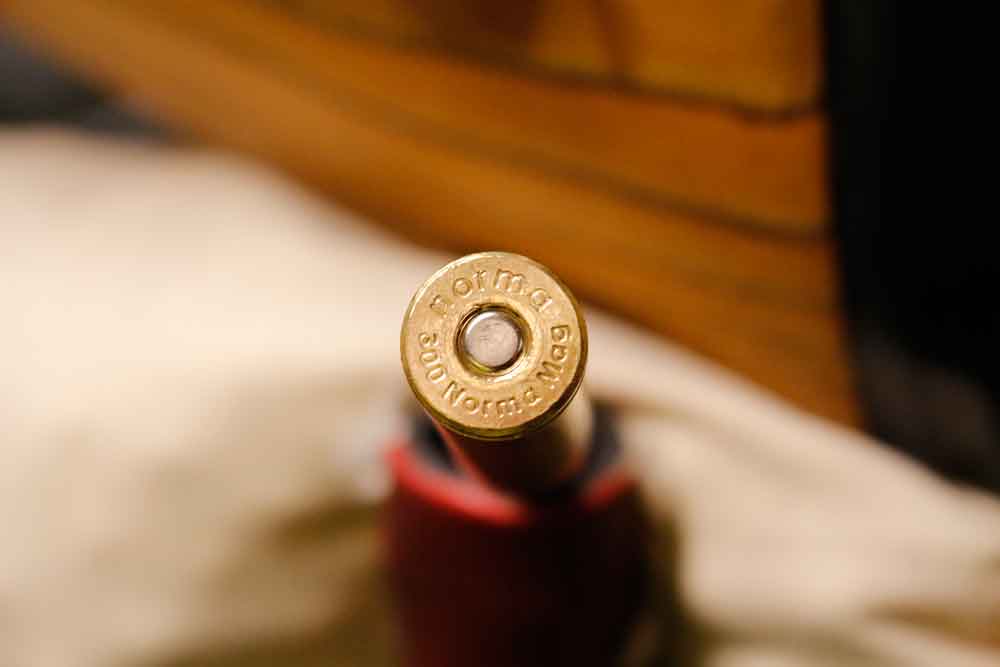
Is the relatively new .300 Norma Magnum a true heavyweight contender, and what can handloaders do with it?
- The .300 Norma Magnum is based on the earlier .338 Norma Magnum.
- At the range, the .300 Norma Magnum held sub-MOA with several bullets designs.
- One group shot at 500 meters measured 1.45 inches.
- Bullet choice for reloaders depends on the intended application — many options exist.
- With a 230-grain bullet, the .300 Norma Magnum remains supersonic to 1,500 yards.
Amotfors, Sweden was not quite the town I expected. It lies just east of the Norwegian border and is rather quaint with its White Moose Hotel, a surprisingly decent pizza joint and an American sports bar. It has a large railway station, and the waterfront in town will actually bring you out to the North Sea. However, its claim to fame is that it is where Norma Precision AB calls home. I was invited to visit the factory — where the magic happens — and meet the key players involved in the development of Norma’s fantastic ammunition and components; it was certainly an eye opener.
The plant employs over 200 people, including some who have enough shooting medals to sink a battleship. First, as a reloader, let me report that the processes involved with making their brass cartridge cases were correlative to the quality of that brass; I now understand why I like it so much. But among all the wonderful folks I met, and all of the sneak peeks behind the curtain, the thing that intrigued me the most was Norma’s new .300 Magnum.
Now, Norma is no stranger to cartridge development, with its .308 Norma Magnum predating the .300 Winchester Magnum and its 6.5-284 Norma firmly established as a benchrest cartridge, not to mention the .358 Norma Magnum. However, the .300 Norma, and its big brother, the .338 Norma Magnum are two very solid developments, each capable of excellent accuracy as well as high velocity.
 Introduction To The .300 Norma Magnum
Introduction To The .300 Norma Magnum
My first date with the pair was at the RWS factory in Nuremburg, Germany, when, at a shooting competition among gun writers, I took second by printing a 1.69-inch three-shot group on the 500-meter range. Yes, that’s right. I was beat by a group measuring 1.45 inches; this cartridge is a shooter.
I got the skinny on the younger brother — the .300 Norma — while having a sit down in the Norma Headquarters and immediately recognized the handloading potential of an already excellent factory cartridge. The pair of cartridges is based on the .338 Lapua — in turn based on the .416 Rigby case — shortened to 2.492 inches, yet maintaining a maximum C.O.L. of 3.600 inches — the same as the .375 H&H Magnum. This allows the longest and sleekest bullets to be seated out plenty far enough to maximize the case capacity.
With a case head diameter of 0.588 inch and a steep 20-degree shoulder, the .300 Norma Magnum has a large powder column, but it resembles the profile of the short magnums more than the long, thin belted magnums of the 1960s. The design was a joint effort between Jimmy Sloan and Norma, and it has proved to be more efficient than the longer Lapua offering.
 Powder & Primer Considerations
Powder & Primer Considerations
At the range, the .300 Norma Magnum proved to be a very accurate cartridge, holding sub-MOA accuracy with several different bullets. Factory stuff aside, in the handloading realm, I was curious to find out what makes the .300 Norma tick, so we can find an easy starting point for our handloads. What I’ve found makes perfect sense and might cause you to experiment with some different powders that might be foreign to you. Norma Precision — rather obviously — uses Norma powder for its ammunition. Here in the United States, Norma powder is imported and distributed by Western Powder (WesternPowders.com) and is a vastly overlooked source of excellent handloads. I’ve used Norma 200 to fuel several safaris, as it makes a wonderful choice in the .375 H&H Magnum and will deliver serious accuracy with the 235- and 250-grain bullets.
Norma recommends two powders for use in the .300 Norma Magnum: the proven MRP and Norma 217. To translate into terms we all know, the MRP has a burn rate in the vicinity of Alliant Reloder 22 or IMR 7828, while Norma 217 is one of the slowest burning powders, hanging out with Alliant Reloder 25. So, even if you don’t choose to follow in Norma’s powder choice, this should give you an idea where to start; powders with a burn rate equal to or slower than RL-22 should give positive results. I’m certain that the Enduron IMR7977 and Hodgdon’s RETUMBO would also make worthy candidates. The .300 Norma case has a capacity of 103.0 grains of water, so powder charges will approach 90 grains or more, depending on the bullet weight.
Regarding primer choice for the .300 Norma Magnum, you’ll most definitely want a good large rifle magnum primer to ignite that powder column, especially since powder charges can exceed 90 grains. Experimenting with different primer types (please start load development from the bottom of the load data, as pressures can spike quickly in a cartridge this large) might show a significant difference in accuracy results, and once you find that combination of powder/primer/bullet in your rifle, get it tattooed on you forearm, so it’s never lost.
The Right Bullet For The Job

Bullet choice for the .300 Norma Magnum is going to depend on the application. If you’re into the truly long-range game, the .300 Norma Magnum might be a dream come true, as it was designed around the 230-grain Berger OTM Hybrid bullet. This bullet uses an optimum blend of secant and tangent ogive curves to best engage the rifling and yet maximize downrange performance. I like any bullet of 180-grains on upward, with the best ballistic coefficient (BC) I can obtain.
For the target game, think the Sierra 220-grain MatchKing, the Hornady 225-grain ELD-Match (with a G1 BC of 0.777, woof!), those great Berger offerings and the like. For a hunting scenario — and I feel the .300 Norma Magnum could make a great elk, moose and bear rifle — bullets like the 180-grain Swift Scirocco II, the 220-grain ELD-X and the Nosler AccuBond Long Range at 190 and 210 grains will all provide excellent terminal ballistics, in addition to good wind deflection characteristics.
And the beauty of the .300 Norma Magnum is that all of these long-for-caliber bullets can be seated out far enough to keep the shank of the bullet — before the ogive — at the case mouth. I’ve had issues with the .300 Win. Mag. when trying to use long-ogive bullets and maintain the SAAMI-specified C.O.L. measurement.
What about the velocity? Well, with a case like the .300 Norma, the velocity is certainly there. The 220-grain slugs can be driven to just over 3,000 fps, and the 230-grain bullets just 50 fps slower. A good 180-grain hunting bullet can easily reach 3,250 fps, putting the .300 Norma in between the .300 Weatherby/30 Nosler and .300 Remington Ultra Magnum/.30-378 Weatherby on the velocity scale. In my experience, the recoil of the .300 Norma is manageable, about on par with the .300 Winchester, maybe a bit more, but nothing horrendous.
 Parting Shots
Parting Shots
So, do we need another .30-caliber magnum? I mean, with the plethora of cartridges launching a .30-caliber bullet, couldn’t we make do with what we have already? The .300 Winchester Magnum is a fantastic cartridge, and the .300 Weatherby and .300 Holland & Holland each have their following, not to mention the .300 Remington Ultra Magnum crowd, as well as those who’ve taken to the .300 Winchester Short Magnum.
Well, the U.S. military seems to believe the answer to that first question is a definite affirmative. SOCOM has adopted the .300 Norma Magnum for its Advanced Sniper Rifle, more than likely due to the fact that the .300 Norma will remain supersonic — with the 230-grain bullet — as far as the .338 Lapua will with its 300-grain pill; both go transonic somewhere around 1,500 yards. Based on my experiences with the factory loads for the .300 Norma Magnum, I am eagerly awaiting my test rifle so I can begin tweaking the handloads. Keep your eye on this cartridge; I feel Norma has got something very special here.
Editor's Note: This “Reloading Bench” column is an excerpt from the August 2017 issue of Gun Digest the Magazine.

Next Step: Get your FREE Printable Target Pack
Enhance your shooting precision with our 62 MOA Targets, perfect for rifles and handguns. Crafted in collaboration with Storm Tactical for accuracy and versatility.
Subscribe to the Gun Digest email newsletter and get your downloadable target pack sent straight to your inbox. Stay updated with the latest firearms info in the industry.

 Powder & Primer Considerations
Powder & Primer Considerations Parting Shots
Parting Shots![Best Concealed Carry Guns In 2025 [Field Tested] Wilson Combat EDC X9S 1](https://gundigest.com/wp-content/uploads/Wilson-Combat-EDC-X9S-1-324x160.jpg)


![Best 9mm Carbine: Affordable PCCs [Tested] Ruger Carbine Shooting](https://gundigest.com/wp-content/uploads/Ruger-Carbine-Shooting-100x70.jpg)
![Best AR-15: Top Options Available Today [Field Tested] Harrington and Richardson PSA XM177E2 feature](https://gundigest.com/wp-content/uploads/Harrington-and-Richardson-PSA-XM177E2-feature-100x70.jpg)

I am starting to load 300 nm, but not sure what type of die set to use[full or neck sizing ]. I like Redding or Hornady. can you help?